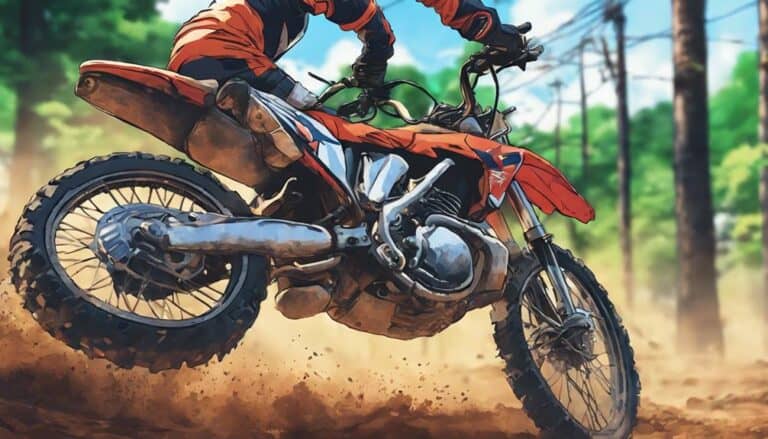Imagine the clutch lever on your dirt bike as a conductor's baton, directing the harmony between your engine and wheels. As you grip the lever and feel the subtle dance of engagement, it's important to understand the finesse required for seamless gear shifts.
But hold on, there's more to this important skill than meets the eye. Let's explore how mastering the manual clutch operation can elevate your dirt biking experience to new heights.
Key Takeaways
- Master clutch modulation for precise power management.
- Practice smooth clutch engagement and throttle coordination.
- Understand the friction zone for control and balance.
- Develop muscle memory through consistent clutch control practice.
Understanding the Clutch Lever
When operating a manual clutch on a dirt bike, understanding the function and control of the clutch lever is essential to mastering the gear changes and maneuvering effectively.
The clutch lever on a dirt bike is typically situated on the left side of the handlebars. When you pull the clutch lever, it disengages the engine from the transmission, enabling you to shift gears smoothly or come to a stop without killing the engine.
Releasing the clutch lever gradually re-engages the engine with the transmission, providing power to the wheels and allowing you to accelerate. Proper adjustment of the clutch lever play is vital for ensuring smooth operation and control over the bike.
Shifting Gears Smoothly
To shift gears smoothly on a dirt bike, pull the clutch lever towards the handlebar to disengage the engine from the transmission. While the clutch is pulled in, use the shifter to select the desired gear, then release the clutch gradually to engage the new gear. Listening to the engine sound is important for determining the right moment to shift gears, ensuring a seamless power delivery handover. Here are some gear selection tips, smooth handover techniques, and engine sound cues to help you master the art of shifting gears smoothly:
| Gear Selection Tips | Smooth Handover Techniques | Engine Sound Cues |
|---|---|---|
| Anticipate gear changes | Match engine speed to gear | Smooth, steady sound |
| Shift at appropriate RPM | Use gentle pressure on shifter | Consistent pitch |
| Avoid lugging the engine | Release clutch smoothly | Crisp and clear |
Applying these strategies will enhance your gear shifting skills and make your riding experience more enjoyable.
Finding the Friction Zone
To improve your clutch control and enhance your riding skills, mastering the friction zone on a dirt bike is key for achieving smooth and controlled starts.
The friction zone on the clutch is that critical point where the engine's power is transmitted to the transmission. To find this zone, slowly release the clutch lever while gently applying throttle until you sense the bike starting to move forward. This requires a delicate balance between throttle input and clutch engagement.
By practicing this technique, you'll improve your ability to find and control the friction zone, ultimately enhancing your overall riding experience.
Mastering balance, improving coordination, and enhancing control are essential components of successfully maneuvering the friction zone. This skill is particularly crucial for challenging terrains and slow-speed maneuvers.
Understanding and utilizing the friction zone effectively won't only prevent stalling but also provide you with better control over your bike in various riding scenarios.
Proper Clutch Control Techniques
For best control of your dirt bike, mastering proper clutch control techniques is essential. Clutch modulation is the art of smoothly engaging and disengaging the clutch lever to manage the power delivery effectively.
When shifting gears, smoothly pull in the clutch lever to disengage the engine from the transmission. Gradually release the clutch lever while adding throttle to seamlessly transfer power to the rear wheel. This riding technique allows for precise control of speed and power delivery, enhancing overall stability on your dirt bike.
Understanding the friction zone of the clutch is vital for smooth take-offs and maneuvering at low speeds. By mastering clutch control, you can achieve better balance control, enabling you to handle various terrains and obstacles with finesse.
Practicing Clutch Engagements
Practicing clutch engagements requires a deliberate and gradual approach to developing precise control over your dirt bike's power delivery. To master clutch modulation, focus on engaging the clutch slowly and smoothly to prevent jerky movements that could lead to loss of control, especially on slippery terrain. Developing a keen sense of the clutch engagement point through practice will enhance your muscle memory, allowing for more precise control. Experiment with various techniques to determine what suits your riding style and comfort level best. When tackling hill starts, remember to gradually release the clutch to smoothly shift between gears and prevent stalling. Utilize feedback from the bike, such as engine sound and bike response, to fine-tune your clutch engagement skills and elevate your riding experience.
| Clutch Modulation | Slippery Terrain | Hill Starts |
|---|---|---|
| Engage slowly and smoothly | Be cautious on slippery surfaces | Gradually release clutch on inclines |
Conclusion
To summarize, mastering the manual clutch on a dirt bike is essential for smooth gear shifts and controlled stops. Remember, practice makes perfect, so don't be afraid to get out there and hone your skills.
Keep in mind that 'practice makes perfect' and soon enough, operating the clutch will become second nature. Keep practicing and pushing yourself to improve your technique for a more enjoyable riding experience.

